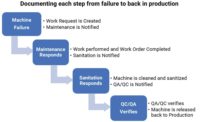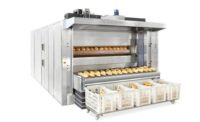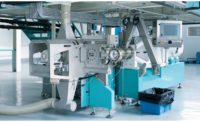Flexibility, greater sanitation, gentle handling of ingredients, quicker changeovers, more precise weight control, and the ability to make products with healthier ingredients are top of mind features and benefits for snack and bakery customers of extrusion equipment and technology.
Market demands
“Customers do not want dedicated equipment anymore,” says John McIsaac, vice president of strategic business development for Reiser, Canton, MA. “They do not want dividers that produce only one type of product.” Flexibility is the key, he notes, along with gentle handling.
Jeff Zeak, bakery specialist with Reiser, adds that customers want superior finished product quality, portion weight control accuracy, ease of machine use and sanitation, low cost of ownership, and flexibility of equipment capability.
Customers of Buhler Group, Uzwil, Switzerland, don’t expect many global changes in twin-screw extruder, aside from sanitary improvements, says Michael Shaw, sales manager, North America, extrusion, snacks and cereals. “They want less flat surfaces—more rounded. Things like that,” he says.
Greater uptime with fewer changeovers are among the most frequent requests from customers of Franz Haas Machinery of America, Inc., Williamsville, NY, says Kevin Knott, key account manager. Weight control is also paramount, especially considering the cost of ingredients, he says. “We’re reducing giveaway by hitting the weights more precisely.”
Rick Warner, director of sales, American Extrusion International, South Beloit, IL, says his customers want equipment that can handle higher percentages of plant-based protein and/or multigrain recipes. “There is a general trend to meet the demand for healthier snacking options,” he says.
Customers of Andy J. Egan Co., Inc., Grand Rapids, MI, seem increasingly interested in toppings on products that provide higher nutritional content, says Mike Sherd, managing partner. “We’ve sprinkled anything from sesame seeds to dried fruits,” he says. “A lot of customers will have us top it and then lightly press it into the top of the product.”
Plant protein bases and clean label snacks are high priorities for Jose Coelho, president, Clextral USA, Tampa, FL. “Our customers are looking to develop new, trendy snacks that are at the same time tasty, healthy, and with ingredient origins and processes that are good for our environment,” he says. “The good news is that these new ingredients and products do not necessarily require new extrusion equipment or technology, as the twin-screw extruder is highly adaptable and flexible.”
More nutritional snacks and baked goods have been top requests from customers of Baker Perkins, Peterborough, England, says Keith Graham, business development manager. “Twin-screw extrusion can be utilized to penetrate this expanding market for foods high in fiber and protein. Proteins from wheat, dairy, soy, or pulses, as well as fiber, can be added to co-extruded products.” Gluten-free is another category seeing rapid growth. “Again, extrusion can help manufacturers respond to demand by using flours from gluten-free grains,” he says.
New and improved
Reading Bakery Systems, Robesonia, PA, has rolled out a co-extruder that can cut in front of the oven, set up with a wire cut mechanism. New in 2019, the Genesis Pro WCS300 encompasses two servos on the feed rolls, four on the wire cut mechanism, three on the cutter and one of the belt, says Sam Pallottini, director of cookie, cracker and pet food sales. “The design of the machine is capable of doing so much,” he says. “The biggest feature that separates this from everything else is the linear servo-cutting system that pinches the ends prior to the bake.” That enables the user to construct miniature bite-sized pastries.
Reiser has introduced several new technical advances in recent months, starting with a 33 percent larger infeed for double-screws on the Vemag divider, McIsaac says. “This means less work on the dough as it flows into our exclusive double-screw pumping system,” he says. “It allows our customers to expand the types of variety breads they can offer. They can produce higher-volume breads. They can produce both a closed or open crumb structure with the same machine.”
For smaller producers, Reiser has introduced the V2 cutter, a servo-driven portioning system that increases production rates on Vemag 500 series machines. “The servo drive eliminates pneumatics, and improves on our benchmark scaling accuracy,” McIsaac says. Reiser also has partnered with Gemini to produce full rolls lines, dividing them directly into the pan and using a horizontal discharge system to replace vertical chutes. “We have full control of the dough ball from divider to pan,” he says. “Teamed with a Vemag divider, it allows the high-speed production of sort rolls and profitable hard or hybrid rolls on the same system.”
Reiser has also added line extensions for its Vemag MMP223 high-speed cutting device for protein and meal-replacement bar extrusion portioning; the BC236 and BC237 ball control machines for production of sphere and multi-shaped, high-protein, and Keto-friendly snacks and pet food treats; and the multi-lane co-extrusion servo crimper system for filled products like bagel bites, calzones, empanadas, and breadsticks, Zeak says.
Buhler Group has been promoting its AeroExpander unit that’s mostly sold internationally to U.S.-based snack managers looking to produce pellet-based snacks. Available in three sizes, the main benefits are that it’s horizontal and provides both low-pressure and high-pressure extrusion. “Instead of the traditional way of a rotary drum—with pellets bouncing all over the place, and some over-popped, and some under-popped, and you don’t get a lot of consistency—in the bucket you get very consistent airflow, very consistent exposure to heat, and uniform popping,” Shaw says. “It’s an inexpensive way for a smaller company to get into the snack and cereal business.”
Franz Haas, which is part of Buhler Group, has developed a machine, called the 6110, with a removable head that’s used to make higher-end high-protein bars, which allows quick changeovers, Knott says. “We developed a system to take the extrusion head offline onto a cart, put a second one back on, so they can be up and running within 20 minutes, instead of a two- to four-hour shutdown,” he says. Developed originally for a particular customer, the 6110 has since been sold to others, he adds.
Andy J. Egan Co. produces machines to handle extruded bars, and primarily does custom builds, Sherd says. Recent custom machines have included direct-drive motors with no gears, parts that can be removed without tools for easy cleaning, and a lack of bolt holes to go with the lack of bolts—which cuts down on places that could harbor bacteria, he says. The company’s new four-roll co-extruder reduces product changeover time and adds flexibility. It also can be adapted for use as a two-roll extruder when single-layer products are required.
Baker Perkins has enhanced its wirecut extrusion machines with weight control technology that’s added to the profitability of cookies and bars, reducing variations in piece weights by individually adjusting the output from each die cup, Graham says. “The savings in dough and waste, and the economic benefits, are significant,” he says. “These wirecuts cover a wide range of cookie and bar applications for high-fat soft doughs.”
The latest TruClean servo wirecut from Baker Perkins offers a combination of automation and economy, Graham says. “Outstanding flexibility and process control are key attributes of the patented two-axis servo system,” he says. “Tailored profiles can be treated for each individual product and loaded at the touch of a button, improving ease of operation, product changeover times, cleaning, and maintenance.”
Known for its single-screw and rotary-head extruders that make sheeted chips, co-extruded snacks, sticks and three-dimensional shapes, American Extrusion has brought to market its first twin-screw extruder, Warner says. “New items in addition to the twin-screw extruder are a tube cutter that cuts various lengths of tubes, such as a churro-type product, and an adaptation to our crimping machine that makes green pea pods,” he says. “Our technology focuses on keeping the process simple and easy to operate, while allowing a lot of flexibility in terms of raw material usage.”
Clextral has worked on developing snack lines designed to be flexible for rapid product changes when running high capacities without losing production efficiency, Coehlo says. “Particular attention to sanitary design and higher capacities were integrated into our clip-on equipment that makes new snack product shapes post-extrusion, and also equipment to add ingredient inclusions in the extruded melt,” he says. “These developments will allow our customers to build their new product portfolios, using existing lines without major investments and following the latest operational sanitary requirements.”




